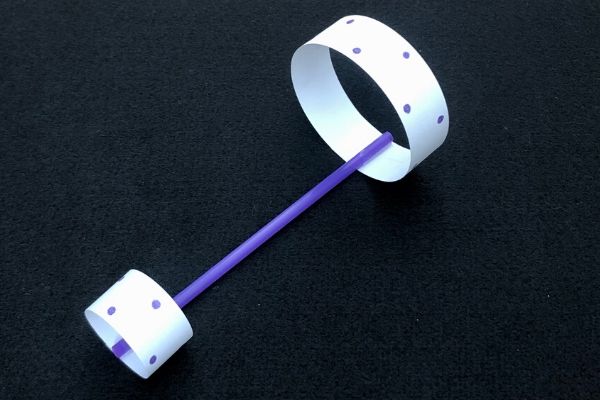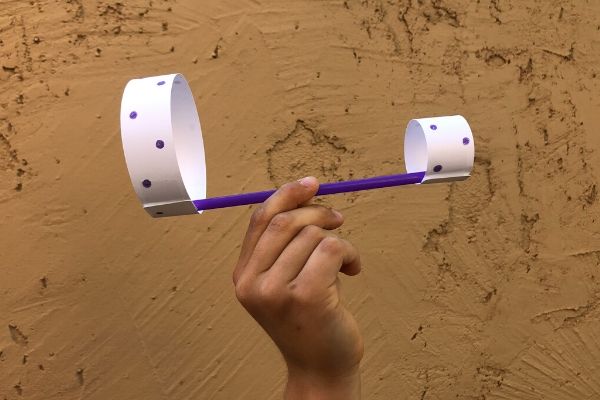Move over paper airplanes! This straw and paper airplane is easy to make (no origami involved!) and flies like a champ.
I know it looks funny and you might be skeptical that these paper hoops can really fly. After all, most paper airplanes are flat with wings. But these “Hoopsters” are easy to throw and they fly in straight lines.

How to Make a Hoop Glider
Materials:
- Cardstock paper (8”x11”)
- Ruler
- Scissors
- Drinking straw (if you have a bendy straw, cut the accordion part off)
- Tape
- (Optional) Straw Airplane Template
Instructions:
- You have 3 options when it comes to cutting the cardstock paper:
- Cut the cardstock paper so you have 3 strips pieces measuring 5”x1”. Take 2 of the strips and tape them together so now you have a 10”x1” strip.
- Cut the cardstock paper so you have 1 strip that is 10”x1” and 2 strips that are 5”x1”.
- Print the Straw Airplane Template on cardstock paper and cut along the outlines for the 2 strips.
- Curl the 5”x1” strip into a hoop and tape the ends together.
- Repeat with the 10”x1” strip.
- Tape the hoops to the two ends of the straw. Make sure the straw is on the inside of the hoops and lined up.
- Hold the hoop glider in the middle of the straw with the little hoop in the front and throw!
Not hard at all right? My 3 years old was able to make one by herself after watching me make one. Alas, hers was decorated with tons of stickers and she insisted on putting tape all over the hoops. But it flew!

The Science Behind the DIY Straw Airplanes for Kids
There are 4 forces at work behind the hoop glider.
- The thrust is the force that pushes the straw glider forward. When you launch the straw airplane with your hand, you are generating enough thrust that allows the plane to move through the air.
- Drag, or air resistance, is the force that acts in opposition to the thrust. Drag is what slows the airplane down.
- Air moves through the hoops and provides lift, or the force that keeps the airplane up.
- Gravity is the force that pulls the hoop glider downward and acts against the lift. As the airplane slows down due to drag, the strength of the lift lessens and gravity pulls the glider down to the ground.
STEM Extensions
There are many experiments you can do with this STEM activity. Try the following and observe the impact of these experiments on the flight of the straw airplane:
- Try making the hoopster with a shorter or longer straw.
- Move the bigger hoop toward the middle of the straw.
- Instead of one small hoop and one big hoop, try making the straw airplane with two small hoops and two big hoops on one straw.
- Tape the hoops on the straw so they are not in line.
- Add weight to the glider by attaching a paper clip to the bottom of the small hoop.
- Use two hoops that are the same size.
- Use a stick (or something without a hollow center) instead of a straw.
- Try using lighter or heavier weight paper.
You can also try throwing the straw airplane and make it turn. Can you do it, or does it fly in a straight line no matter what?
Final Thoughts on the Straw Airplane
The hoopster, straw airplane, hoop glider, or whatever you call it is a lot more fun than a paper plane.
Because it can fly straight and cover a long distance, we decided to play games with it!
First, my kids rode around on their bikes and I try to hit them with the hoop glider.
Then, we tried throwing the hoop gliders at different targets to see how well we can aim.
Point is, use your imagination!
The post How to Make a Straw Airplane appeared first on Mombrite.

